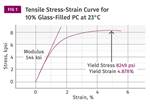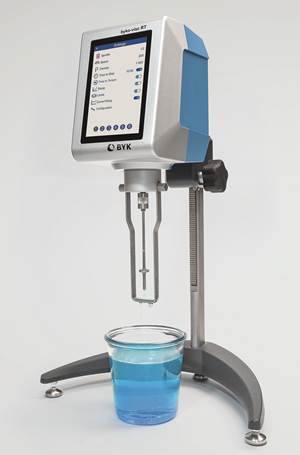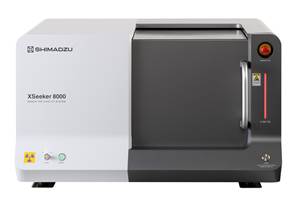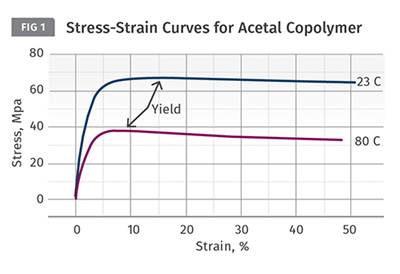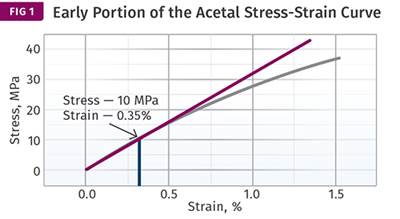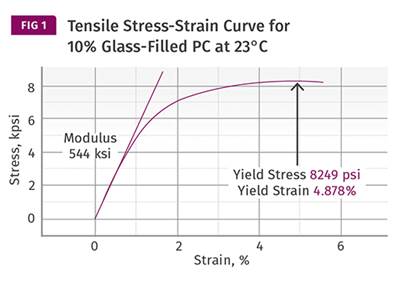MATERIALS: The Problems with Single-Point Data
In plastics, notched Izod and Charpy test results have been complicated by the way they are reported.
Up to this point, we have been looking at load-bearing properties such as strength and modulus and how they are influenced by temperature. Now it is time to look at the other side of the coin— impact properties. Strength and stiffness are related to load-bearing performance and are associated with long-term considerations such as creep resistance and fatigue resistance. Impact tests are designed to measure ductility, which is also referred to more generically as toughness.
In material formulations, impact resistance is almost always at odds with load-bearing properties. For example, we can add glass fiber to a material to increase strength and modulus, but in the process the material becomes more brittle. We can incorporate an impact modifier into a polymer to improve toughness, but strength and stiffness will decline. Finding the right material for an application often involves balancing these competing objectives.
Temperature has a similar contradictory influence on these properties. Increasing temperature tends to reduce load-bearing properties while improving ductility, and decreasing temperature has the opposite effect. Therefore, while the effects of higher temperatures are usually of concern when strength and modulus are at a premium, it is the effect of lower temperatures that is of greatest concern when impact performance is desired. As with most of the properties we have discussed so far, the majority of the published data on impact performance focuses on room-temperature properties.
However, if impact performance is measured at other temperatures, these temperatures will always be below room temperature. Common benchmarks are 00 F (-18 C) and -40 F (-40 C).
It is worth taking some time to look at the tests that are most often used to measure impact performance in plastics. The most popular test in North America is the notched Izod test while the counterpart that seems to be currently favored in Europe is the Charpy test. They have some similarities and some distinct differences. Both tests were developed in the first decade of the 20th century and are named after their creators.
They were created for the metals industry at a time when the use of steel was increasing rapidly and displacing more traditional materials of the time such as stone, brick and wood. It was becoming more important for engineers to understand the properties of steel under a rapidly applied load. During this time it was discovered that ductile materials did not fail unless a notch was created in the specimen.
Early in the development of plastic materials the industry was looking for some guidance on how to assess toughness, and we settled on these tests. Both tests involve a swinging pendulum that strikes a sample mounted in a manner that depends upon the test method. The Izod test holds the sample in a cantilevered beam configuration and the sample is struck on the same side that the notch is cut. The Charpy test mounts the sample in a three-point bending mode and the side opposite the notch receives the impulse from the hammer swinging with the pendulum.
Comparing the results of the two tests is an interesting endeavor, to say the least. The differences in the way the stress of the event is managed by the different sample and test configurations would be expected to be the primary challenge. But the plastics industry has managed to make it much more complicated because of the way the results have traditionally been reported. For whatever reason, until recently the notched Izod results have been reported in terms of energy lost per unit thickness at the notch so the units are ft-lb/in. or joules/m. Since the traditional sample width is 0.500 in. and the depth of the notch is 0.100 in., the denominator used in the calculation was usually 0.400 in., the amount of material remaining after the notch was machined into the sample. (We’ll discuss later why it is machined and not molded in). The results from the Charpy test are reported in terms of energy lost per unit area at the notch.
Therefore, the units are ft-lb/in.2 or J/m2 (kJ/m2 is more common). So even though the thickness of the notched Izod specimen can vary anywhere from 0.118 in. (3 mm) to 0.500 in. (12.7 mm), somehow no one thought it was terribly important to provide the notched Izod results in a manner than took sample thickness into account. The Izod standard has caught up in the last few years, so you will now find notched Izod results reported using both the old method and the updated method. Translating the old notched Izod data to either newer notched Izod results or Charpy results is not simply a matter of unit conversion. You have to know the thickness of the samples that were being tested in order to do the math. The assumption is often made that the specimens were 0.125-in. thick, but there are plenty of old notched Izod test results in the literature that used a 0.250-in. thick specimen. (Confused yet? Just wait, it gets better).
By the 1940s, at about the time that the plastics industry was just starting to adopt these tests, the metals people were wrestling with something known as the ductile-to-brittle transition temperature. Their attention was drawn to this by a substantial number of catastrophic failures of steel ship hulls in cold-water environments. This represented a considerable advance over the traditional approach of focusing on impact performance only at room temperature, and the tests were expanded to be performed at multiple temperatures so that a definitive determination of this transition temperature could be made. Unfortunately, the plastics industry did not get the memo.
While ductile-to-brittle transition temperatures exist in plastics and are very important in determining suitability for use in low-temperature environments, very little data exists in the literature on impact resistance at anything other than room temperature, and almost no work has been done on defining ductile-to-brittle transition temperatures.
When a brittleness temperature is referred to it is typically measured using a standardized test that generates the impact load at a very slow rate and therefore reports a ridiculously low temperature. An example that can actually be found on some data sheets is the brittleness temperature for polycarbonate, given as -102 C (-152 F). And yet impact tests designed to assess practical toughness in polycarbonate under more “real-world” conditions typically demonstrate a brittle response somewhere between -20 and -40 F (-29 and -40 C) even for grades with superior impact resistance.
This brings us to another important consideration when evaluating impact performance: the velocity of the test at the moment of impact. Interestingly, this is another application of the time/temperature/strain-rate equivalence that we discussed last month in relation to tensile properties. An impact test performed at the same temperature but at two different velocities can produce dramatically different results.
The automotive industry pays attention to this; they mandate that impact tests be performed at two velocities: 2.2 m/sec and 6.6 m/sec. A material often will respond in a ductile manner at the slower speed and in a brittle manner at the higher one, even though the temperature of the test is unchanged. So it turns out that there is also a ductile-to-brittle transition in strain rate. What’s interesting is that the Izod and Charpy tests, as conducted by the plastics industry, make no provision for altering the velocity of the test in any significant way.
So how do the automotive people do this? That will be part of our discussion next month.
Related Content
Try This Alternate Method for Heating Your Torque Rheometer
Rheometers are generally not on all the time. And most users have found that the first test run in the instrument after heating up is not very reliable and is usually discarded. Try this method instead.
Read MoreHow to Optimize Color Evaluation of Recycled Plastics
The right color measurement instrument and good working methods will minimize variability in color evaluation of PCR.
Read MoreRobust Rotational Viscometer
Versatile viscometer line said to offer robust measurement, repeatability and reporting.
Read MoreX-Ray Vision Inside Parts Gets More Affordable for Processors
Shimadzu’s new benchtop x-ray CT scanner provides internal and external metrology and flaw detection at a fraction of the previous cost.
Read MoreRead Next
MATERIALS: The Problems With Single-Point Data
Polymer properties are not constant as a function of temperature, and even small temperature changes can affect properties.
Read MoreRendimiento de los polímeros: problemas con datos a una sola temperatura
En una hoja de datos, las propiedades de los polímeros se dan generalmente a una sola temperatura. Pero ¿se mantienen esas propiedades cuando se cambian las temperaturas? Por supuesto que no.
Read MoreMATERIALS: The Problems with Single-Point Data
Engineers who are used to working with metals are surprised that plastics cannot operate as close to their yield points as can metals. The yield point is not enough to tell you how the material reacts to stress.
Read More
.jpg;width=70;height=70;mode=crop)


